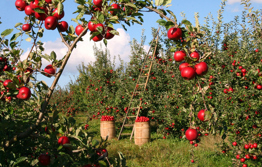Re'eh: Shechem – on Location and Unity

What is meant by derech mevo hashemesh and why is it used as a landmark to identify the ceremony of blessings and curses? Plus: Shechem as a place of national unity or national disaster—it's in our hands
The Sunset (or Western) Highway
When G-d your Lord brings you to the land which you are about to occupy, you must declare the blessing on Mt. Gerizim and the curse on Mt. Eval. Are they not across the Jordan, just beyond the Sunset Highway in the territory of the Canaanites who live in the Aravah, on the way to Gilgal, near the plains of Moreh (Devarim 11:29–20).
We know about the link between Shechem and Elone Moreh from when Avraham (then Avram) journeyed through the Land of Israel "until Shechem, until Elon Moreh" (Bereshit 12:6). However, the only source in Tanach that clearly links Mt. Gerizim or Mt. Eval with the city of Shechem appears only when Yotam ben Yeruba'al shouts the famous parable of the trees to Ba'alei Shechem, who stand in the valley below (Shoftim 9:7). Even Moshe in our parasha, avoids using the name Shechem, using alternatives to help identify the location of these mountains. Could it be due to the loaded negative national experience with Shechem? It is hard to know. But it seems that Moshe prefers referring to Elone Moreh. Nonetheless, Shechem is chosen as a city of refuge (Yehoshua 20:7).
The ceremony of the blessings and curses, commanded in parashat Ki Tavo (Devarim 27:11–26), took place in in the days of Yehoshua (8:30–35) on the mountains of Gerizim and Eval, with no mention of Shechem.
Possibly, the mountains Gerizim and Eval were so closely linked with Shechem, in the valley between them, it was superfluous to mention the city. Moshe uses a unique phrase, halo hema, "are they not," indicating that the mountains were well known, even to those who had not yet entered the Land of Israel (Rabbi S. R. Hirsch).
Moshe, however, names alternative—and rather ambiguous—landmarks, including: "just beyond the Sunset Highway," "the territory of the Canaanites who live in the Aravah" and "on the way to Gilgal, near the plans of Moreh." Most enigmatic is the phrase אחרי דרך מבוא השמש ("just beyond the Sunset Highway," Kaplan trans.; "the western road," JPS trans.). The Gemara in Sotah (33b) explains this refers to the path of the sun, from sunrise to sunset. It is possible that Moshe Rabeinu wanted to thus express the change that would soon be in the direction of their travels. Until now in the desert, the Jewish People had traveled east, north, and south. After crossing the Jordan River, they will finally go west, along the Sunset Highway to the same Elone Mamrei Avraham visited when he first entered the Land of Israel.
The Gemara (36a) describes the distance between the Jordan River and Shechem, estimating it as 60 mil, a distance the nation traversed twice in the same day: the nation traveled to Shechem for the ceremony and then back to Gilgal. Note that the aerial distance between Jordan, across from Jericho, and Shechem is nearly 60 km, or approximately 60 mil. The Gemara understands that the ceremony of the curses and blessings took place on the day of the Jordan River crossing; however, the peshat (plain meaning of the text) indicates that it took place after the conquering of Jericho and Beit El, however (Shechem is some 30 km north of Biblical Beit El).
Shechem: The place for unity
Now let us discuss the city of Shechem itself. Shechem is depicted in several biblical accounts as a place of impending disaster. From the incident with Dina and Shechem ben Chamor (Bereishit 34); to the sale of Yosef next to Shechem (Bereishit 37); through Avimelech ben Gidon's violent takeover of the tribes of Israel with the help of Ba'alei Shechem (Shoftim 9); up through the split of Rechavam's kingdom, all took place there (I Melachim 12).
As a counterbalance to these calamities, in two biblical accounts Shechem is a venue for unity among the Jewish People: first, the renewal of the covenant between G-d and the Jewish People following the command for the ceremony with the blessings and curses on Mt. Gerizim and Mt. Eval, which Yehoshua carries out after conquering Ai (Yehoshua 8:30–35). The second is towards the end of Yehoshua's time, when he gathers the tribes together for a second covenant prior to his death (Yehoshua 24:1–27). Shechem is also the place of Yosef's burial (Yehoshua 24:32).
These two covenants, Yosef's burial, and unity of the Jewish People are all interconnected and are tied to what Yosef represents. Just as Yosef provides the physical salvation for the Jewish people (and the entire ancient world), Mashiach ben Yosef, according to Chazal, lays the earthly foundations ahead of Mashiach ben David's arrival.
What makes each part of this redemption possible is unity among the nation. And a vital part of this unity is the all-encompassing covenant between G-d and the Jewish People. The covenants in Yehoshua's time were crucial steps, paving the ways for the Jew's redemption.
The incidents of national divisiveness—in the times of Yosef and his brothers, Avimelech, and Rechavam—take place when the nation is not ready for redemption. We see that Shechem, the place supposed to symbolize the beginning of national unification and redemption can also serve as the beginning of its destruction. As we see with the curses and blessings given to us on the mountains on either side of the city, it all depends on our deeds.




